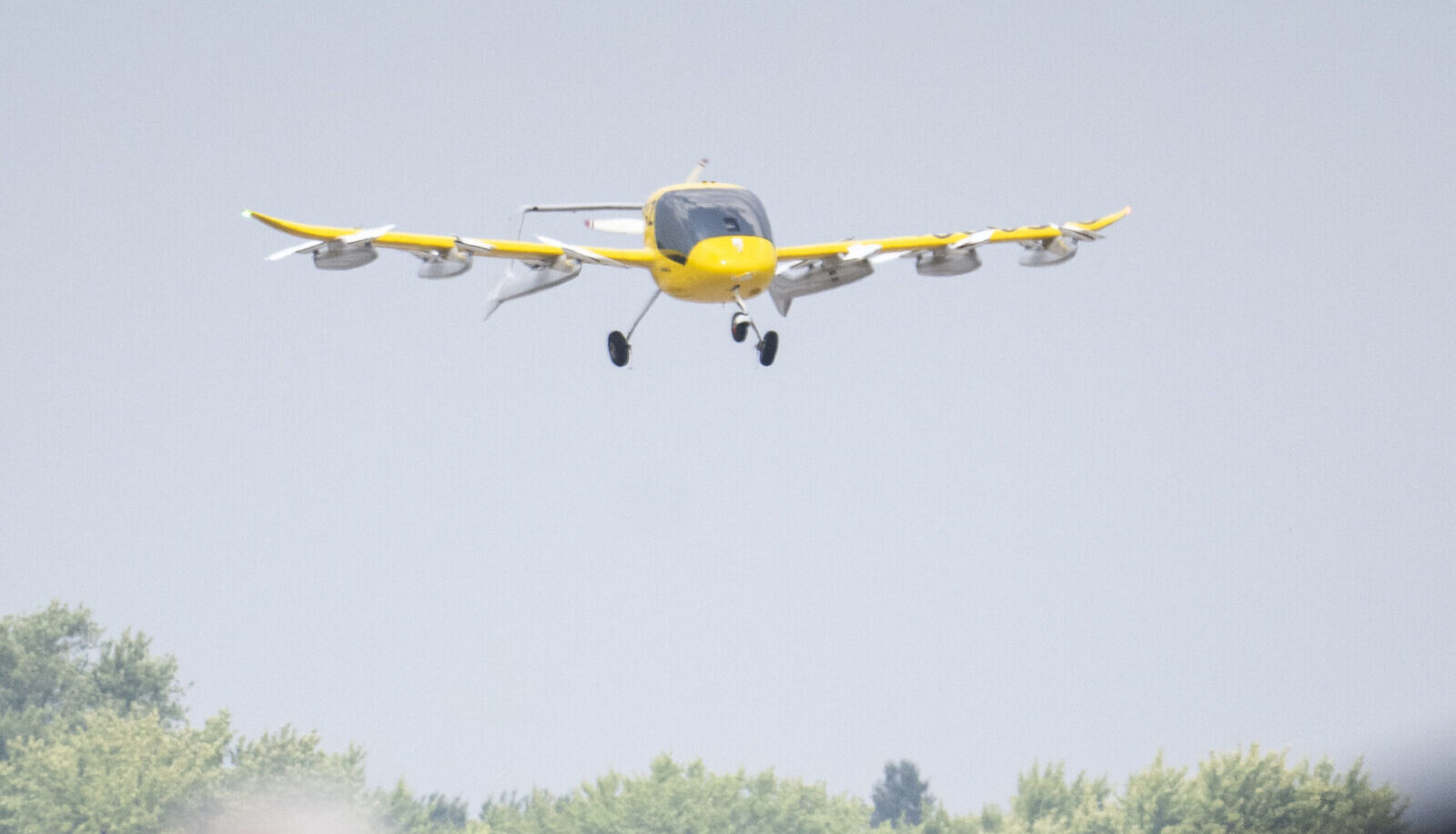Stay Up to Date
Submit your email address to receive the latest industry and Aerospace America news.
Crowds witness remotely piloted air taxi flight
This article has been corrected to indicate that the BlackFly aircraft was a flyable aircraft. It has also been updated to account for the role of the remote pilot of the Wisk aircraft.
EAA AIRVENTURE, Oshkosh, Wisconsin — Crowds at the Experimental Aircraft Association’s annual AirVenture show sweltered in the heat and breathed in air hazy with smoke from Canadian wildfires on Tuesday, but for most it was worth it to glimpse what could be the future: an emissionless aircraft in flight.
A remote pilot for air taxi developer Wisk, a subsidiary of Boeing, supervised the flight of the company’s bright yellow, all-electric Cora aircraft with no one on board. It was the first public flight of the electric vertical takeoff and landing aircraft, or eVTOL. For the Experimental Aircraft Association, the flight also marked the first flight by a remotely piloted aircraft designed for passengers in the show’s 70-year history (Cora can seat two passengers).
The small plane flew low in a straight line up and down the EAA runway, propelled by a single aft pusher propeller, stopping midway under power of its 12 upright rotors to make a full 360-degree turn before landing vertically. Only a low buzzing sound, like a fan spinning, could be heard.
The presence of Wisk and several other eVTOL companies prompted EAA CEO Jack Pelton to declare that advanced air mobility aircraft will have a growing presence at AirVenture.
“I think this will be kind of a landmark year,” Pelton said in a press conference. “We’re going to start moving in that [AAM] direction, as these companies get closer and closer to certification. A lot of them are saying 2024 or 2025 for when they will be certified.”
Pelton noted the participation of Joby Aviation and Archer Aviation of Silicon Valley, and Beta Technologies of Vermont. These eVTOL developers receive funding from the U.S. Air Force’s Afwerx Prime division, the unit of the Afwerx program that’s in charge of “priming” commercial markets to develop dual-use technologies.
“They’re talking about next year having the ability to actually bring their flying platforms here to demonstrate,” Pelton said of the eVTOL developers.
U.S. Air Force Col. Tom Meagher, chief of the Afwerx Prime division, said he also thinks AAM will take a larger presence at EAA soon.
“Obviously most of these companies have been operating from their home base sites, but as they near certification and production they’ll be able to bring more [aircraft] here, and that’s important because it’s important for the public to actually see these flying,” Meagher told me in a brief interview.
Pelton also said he considers the U.K.-based Gravity Industries to be part of the AAM world due to its flight demonstrations here of its Jet Suit, propelled by five gas turbines. Two Gravity pilots donned Jet Suits and flew at the same time in different directions up and down the runway following the Wisk demonstration.
For the first time, Wisk brought a mockup of its Gen 6 production model cabin to the show. Attendees sat in the cabin and watched the safety orientation video that will be shown before takeoff. The Gen 6 is a tiltrotor eVTOL designed to carry four passengers without a cockpit, since it, like the Cora, is largely automated and designed to be monitored by a remote pilot.
Yet another eVTOL maker, California company Opener LLC, brought one of its eight-rotor, single seat BlackFly ultralight aircraft for display.
The company announced during the show that it began an early access program for selected customers, with signed sales contracts and delivery of some aircraft, but has not said how many. Early pilot customers are being asked to provide Opener with feedback about the pilot controls.
The first customer pilot to receive a BlackFly, Tim Lum of rural central Washington state, told me he’s thrilled to be the first and loves the ease of flying the aircraft. He’s a 60-year-old retired smokejumper, meaning he used to parachute into remote areas to fight wildfires.
He said he keeps the BlackFly in his garage and pulls it out by hand on a trailer. He has solar panels on his house and believes he pays about $2 per flight hour to charge the aircraft.
“If I was still working, my office is 5 miles as the crow flies, about 1,000 feet downhill. I could fly the BlackFly to my work, park it, go to work and later commute home uphill, violating absolutely no regulation because it’s a remote area with sparse population,” Lum said.
Get the latest news about advanced air mobility delivered to your inbox every two weeks.
About paul brinkmann
Paul covers advanced air mobility, space launches and more for our website and the quarterly magazine. Paul joined us in 2022 and is based near Kennedy Space Center in Florida. He previously covered aerospace for United Press International and the Orlando Sentinel.
Related Posts
Stay Up to Date
Submit your email address to receive the latest industry and Aerospace America news.




